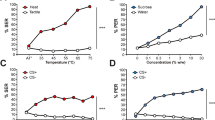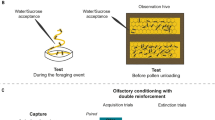Abstract
Laboratory studies in honey bees have shown positive correlations between sucrose responsiveness, division of labour and learning. We tested the relationships between sucrose acceptance and discrimination in the field and responsiveness in the laboratory. Based on acceptance in the field three groups of bees were differentiated: (1) bees that accept sucrose concentrations >10%, (2) bees that accept some but not all of the sucrose concentrations <10% and water, and (3) bees that accept water and all offered sucrose concentrations. Sucrose acceptance can be described in a model in which sucrose- and water-dependent responses interact additively. Responsiveness to sucrose was tested in the same bees in the laboratory by measuring the proboscis extension response (PER). The experiments demonstrated that PER responsiveness is lower than acceptance in the field and that it is not possible to infer from the PER measurements in the laboratory those concentrations the respective bees accepted in the field. Discrimination between sucrose concentrations was tested in three groups of free-flying bees collecting low, intermediate or high concentrations of sucrose. The experiments demonstrated that bees can discriminate between concentrations differences down to 0.2 relative log units. There exist only partial correlations between discrimination, acceptance and PER responsiveness.








Similar content being viewed by others
Abbreviations
- GAS:
-
Gustatory acceptance score
- GRS:
-
Gustatory response score
- PER:
-
Proboscis extension response
References
Barker PDR, Lehner Y (1974) Acceptance and sustenance value of naturally occurring sugars fed to newly emerged adult workers of honey bees (Apis mellifera L.). J Exp Zool 187:277–285
Beutler R (1935) Neue Untersuchungen über den Zuckergehalt des Blütennektars. Leipzig Bienenztg 271–273
Butler CG (1945) The influence of various physical and biological factors of the environment on honeybee activity. An examination of the relationship between activity and nectar concentration and abundance. Exp Biol 21:5–12
Corbet SA (2003) Nectar sugar content: estimating standing crop and secretion rate in the field. Apidologie 34:1–10
Dethier VG, Hanson FE (1968) Electrophysiological responses of the chemoreceptors of the blowfly to sodium salts of fatty acids. Proc Natl Acad Sci USA 60:1296–1303
Erber J, Kierzek S, Sander E, Grandy K (1998a) Tactile learning in the honeybee. J Comp Physiol A 183:737–744
Erber J, Scheiner R, Page R (1998b) Sucrose-perception and learning behaviour in honey bees. Eur J Neurosci 10(Suppl 10):260
Esch H (1962) Über die Auswirkung der Futterplatzqualität auf die Schallerzeugung im Werbetanz der Honigbiene. Verh Dtsch Zool Ges 26:302–309
Evans DR, Mellon D Jr (1962) Electrophysiological studies of a water receptor associated with the taste sensilla of the Blowfly. J Gen Physiol 45:487–500
Farina WM, Grüter C, Diaz PC (2005) Social learning of floral odours inside the honeybee hive. Proc R Soc Lond B 272:1923–1928
Farina WM, Grüter C, Acosta L, Mc Cabe S (2007) Honeybees learn floral odors while receiving nectar from foragers within the hive. Naturwissenschaften 94:55–60
Haupt SS (2004) Antennal sucrose perception in the honey bee (Apis mellifera L.): behaviour and electrophysiology. J Comp Physiol A 190:735–745
Kunze G (1933) Einige Versuche über den Antennengeschmackssinn der Honigbiene. Zool Jahrb Abt Allg Zool und Physiol 52:465–512
Kuwabara M (1957) Bildung des bedingten Reflexes vom Pavlov Typus bei der Honigbiene (Apis mellifica). J Fac Sci Hokkaido Univ Zool 13:458–464
Lacher V (1964) Elektrophysiologische Untersuchungen an einzelnen Rezeptoren für Geruch, Kohlendioxyd, Luftfeuchtigkeit und Temperatur auf den Antennen der Arbeitsbiene und der Drohne (Apis mellifica L.). J Comp Physiol A 48:587–623
Marshall J (1935) On the sensitivity of the chemoreceptors on the antenna and fore tarsus of the honey bee, Apis mellifica L. J Exp Biol 12:17–26
Nicolson SW, Human H (2008) Bees get a head start on honey production. Biol Lett 4:299–301
Page RE, Erber J (2002) Levels of behavioral organization and the evolution of division of labor. Naturwissenschaften 89:91–106
Page RE, Erber J, Fondrk MK (1998) The effect of genotype on response thresholds to sucrose and foraging behavior of honey bees (Apis mellifera L.). J Comp Physiol A 182:489–500
Page RE, Scheiner R, Erber J, Amdam GV (2006) The development and evolution of division of labor and foraging specialization in a social insect (Apis mellifera L.). Curr Top Dev Biol 74:253–286
Pankiw T, Page RE (1999) The effect of genotype, age, sex, and caste on response thresholds to sucrose and foraging behavior of honey bees (Apis mellifera L.). J Comp Physiol A 185:207–213
Pankiw T, Page RE (2000) Response thresholds to sucrose predicts foraging division of labor in honeybees. Behav Ecol Sociobiol 47:265–267
Pankiw T, Page RE (2001) Brood pheromone modulates honeybee (Apis mellifera L.) sucrose response thresholds. Behav Ecol Sociobiol 49:206–213
Pankiw T, Waddington KD, Page RE (2001) Modulation of sucrose response thresholds in honey bees (Apis mellifera L.): influence of genotype, feeding, and foraging experience. J Comp Physiol A 187:293–301
Pankiw T, Nelson M, Page RE, Fondrk MK (2004) The communal crop: modulation of sucrose response thresholds of pre foraging honey bees with incoming nectar quality. Behav Ecol Sociobiol 55:286–292
Raveret Richter M, Waddington KD (1993) Past foraging experience influences honey bee dance behaviour. Anim Behav 46:123–128
Rees CJC (1970) The primary process of reception in the type 3 (‘water’) receptor cell of the fly, Phormia terranovae. Proc R Soc Lond B 174:469–490
Robertson HM, Wanner KW (2006) The chemoreceptor superfamily in the honey bee, Apis mellifera: expansion of the odorant, but not gustatory, receptor family. Genome Res 16:1395–1403
Rodrigues V, Siddiqi O (1981) A gustatory mutant of Drosophila defective in pyranose receptors. Mol Gen Genet 181:406–408
Scheiner R (2004) Responsiveness to sucrose and habituation of the proboscis extension response in honey bees. J Comp Physiol A 190:727–733
Scheiner R, Erber J, Page RE (1999) Tactile learning and the individual evaluation of the reward in honey bees (Apis mellifera L.). J Comp Physiol A 185:1–10
Scheiner R, Page RE, Erber J (2001a) Responsiveness to sucrose affects tactile and olfactory learning in preforaging honey bees of two genetic strains. Behav Brain Res 120:67–73
Scheiner R, Page RE, Erber J (2001b) The effects of genotype, foraging role, and sucrose responsiveness on the tactile learning performance of honey bees (Apis mellifera L.). Neurobiol Learn Mem 76:138–150
Scheiner R, Barnert M, Erber J (2003) Variation in water and sucrose responsiveness during the foraging season affects proboscis extension learning in honey bees. Apidologie 34:67–72
Scheiner R, Page RE, Erber J (2004) Sucrose responsiveness and behavioral plasticity in honey bees (Apis mellifera). Apidologie 35:133–142
Scheiner R, Kuritz-Kaiser A, Menzel R, Erber J (2005) Sensory responsiveness and the effects of equal subjective rewards on tactile learning and memory of honeybees. Learn Mem 12:626–635
Scheiner R, Baumann A, Blenau W (2006) Aminergic control and modulation of honeybee behaviour. Curr Neuropharmacol 4:259–276
Seeley TD (1995) The wisdom of the hive. Harvard University Press, Cambridge
Seeley TD, Mikheyev AS, Pagano GJ (2000) Dancing bees tune both duration and rate of waggle-run production in relation to nectar-source profitability. J Comp Physiol A 186:813–819
Slone J, Daniels J, Amrein H (2007) Sugar receptors in Drosophila. Curr Biol 17:1809–1816
von Frisch K (1927) Versuche über den Geschmackssinn der Bienen. Naturwissenschaften 15:321–327
von Frisch K (1934) Über den Geschmackssinn der Biene. J Comp Physiol A 21:1–156
von Frisch K (1965) Tanzsprache und Orientierung der Bienen. Springer, Berlin
Waddington KD (1982) Honey bee foraging profitability and round dance correlates. J Comp Physiol A 148:297–301
Whitehead AT (1978) Electrophysiological response of honey bee labial palp contact chemoreceptors to sugars and electrolytes. Physiol Entomol 3:241–248
Whitehead AT, Larsen JR (1976a) Electrophysiological responses of galeal contact chemoreceptors of Apis mellifera to selected sugars and electrolytes. J Insect Physiol 22:1609–1616
Whitehead AT, Larsen JR (1976b) Ultrastructure of taste receptors of Apis mellifera L. Am Zool 16:214
Wieczorek H (1980) Sugar reception by an insect water receptor. J Comp Physiol A 138:167–172
Wieczorek H, Köppl R (1978) Effect of sugars on the labellar water receptor of the fly. J Comp Physiol A 126:131–136
Wieczorek H, Shimada I, Hopperdietzel C (1988) Treatment with pronase uncouples water and sugar reception in the labellar water receptor of the blowfly. J Comp Physiol A 163:413–419
Yokohari F (1983) The coelocapitular sensillum, an antennal hygro- and thermoreceptive sensillum of the honey bee, Apis mellifera L. Cell Tissue Res 233:355–365
Yokohari F, Tominaga Y, Tateda H (1982) Antennal hygroreceptors of the honey bee, Apis mellifera L. Cell Tissue Res 226:63–73
Acknowledgments
The work was supported by the Deutsche Forschungsgemeinschaft by funding of the Graduate College “Functional Insect Science”. We wish to thank Benedikt Polaczek for his advice and support in beekeeping. The experiments comply with the current German guidelines for the proper treatment of animals.
Author information
Authors and Affiliations
Corresponding author
Rights and permissions
About this article
Cite this article
Mujagic, S., Erber, J. Sucrose acceptance, discrimination and proboscis responses of honey bees (Apis mellifera L.) in the field and the laboratory. J Comp Physiol A 195, 325–339 (2009). https://doi.org/10.1007/s00359-008-0409-0
Received:
Revised:
Accepted:
Published:
Issue Date:
DOI: https://doi.org/10.1007/s00359-008-0409-0




